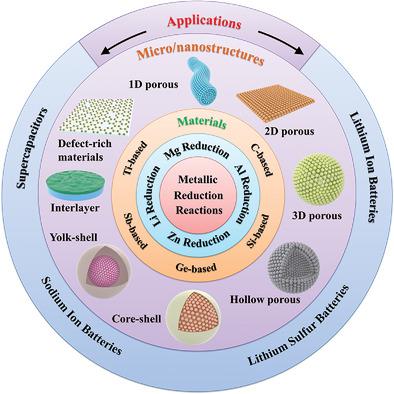当前位置:
X-MOL 学术
›
Small Methods
›
论文详情
Our official English website, www.x-mol.net, welcomes your
feedback! (Note: you will need to create a separate account there.)
Advanced Materials Prepared via Metallic Reduction Reactions for Electrochemical Energy Storage
Small Methods ( IF 10.7 ) Pub Date : 2020-09-02 , DOI: 10.1002/smtd.202000613 Jiaming Zhang 1 , Hanna He 1, 2, 3 , Yougen Tang 1 , Xiaobo Ji 1 , Haiyan Wang 1
Small Methods ( IF 10.7 ) Pub Date : 2020-09-02 , DOI: 10.1002/smtd.202000613 Jiaming Zhang 1 , Hanna He 1, 2, 3 , Yougen Tang 1 , Xiaobo Ji 1 , Haiyan Wang 1
Affiliation

|
Advanced materials with various micro‐/nanostructures have attracted plenty of attention in energy storage field over the past decades. Metallic reduction reactions (MRRs) possess the merits of low energy consumption, flexibility, convenience, and scalability, which have been considered as potential methods to acquire diverse micro‐/nanostructured materials. In this review, the latest progress of MRRs is systematically summed up, featuring the usage of metallic reductants (e.g., magnesium, aluminum, zinc, lithium) on synthesizing of advanced micro‐/nanostructured materials and their applications in various energy storage systems. The as‐obtained materials (e.g., carbon‐, silicon‐, germanium‐, antimony‐, and titanium‐based materials) can deliver various architectures, including solid spherical structures, hollow porous structures, core–shell structures, yolk–shell structures, core–satellite structures, and many kinds of 1D, 2D, 3D micro‐/nanostructures. Besides, the defect properties of materials can be well tuned via MRRs. The application progress of these materials as active electrodes, host materials, or functional interlayers for lithium ion batteries, lithium sulfur batteries, sodium ion batteries, or supercapacitors is reviewed. In the end, the strengths and insufficiencies of MRRs are discussed and the probable future research directions of MRRs are proposed.
中文翻译:

通过金属还原反应制备的用于电化学储能的先进材料
在过去的几十年中,具有各种微/纳米结构的先进材料在储能领域引起了很多关注。金属还原反应(MRR)具有能耗低,灵活性,方便性和可扩展性的优点,被认为是获得各种微/纳米结构材料的潜在方法。在这篇综述中,系统地总结了MRR的最新进展,其特点是在高级微/纳米结构材料的合成中金属还原剂(例如镁,铝,锌,锂)的使用及其在各种储能系统中的应用。所获得的材料(例如,碳,硅,锗,锑和钛基材料)可以提供各种结构,包括实心球形结构,中空多孔结构,核-壳结构,卵黄-壳结构,核-卫星结构以及许多1D,2D,3D微/纳米结构。此外,可以通过MRR很好地调整材料的缺陷特性。综述了这些材料作为锂离子电池,锂硫电池,钠离子电池或超级电容器的活性电极,主体材料或功能中间层的应用进展。最后,讨论了MRR的优缺点,并提出了MRR未来可能的研究方向。审查了锂硫电池,钠离子电池或超级电容器。最后,讨论了MRR的优缺点,并提出了MRR未来可能的研究方向。审查了锂硫电池,钠离子电池或超级电容器。最后,讨论了MRR的优缺点,并提出了MRR未来可能的研究方向。
更新日期:2020-10-07
中文翻译:

通过金属还原反应制备的用于电化学储能的先进材料
在过去的几十年中,具有各种微/纳米结构的先进材料在储能领域引起了很多关注。金属还原反应(MRR)具有能耗低,灵活性,方便性和可扩展性的优点,被认为是获得各种微/纳米结构材料的潜在方法。在这篇综述中,系统地总结了MRR的最新进展,其特点是在高级微/纳米结构材料的合成中金属还原剂(例如镁,铝,锌,锂)的使用及其在各种储能系统中的应用。所获得的材料(例如,碳,硅,锗,锑和钛基材料)可以提供各种结构,包括实心球形结构,中空多孔结构,核-壳结构,卵黄-壳结构,核-卫星结构以及许多1D,2D,3D微/纳米结构。此外,可以通过MRR很好地调整材料的缺陷特性。综述了这些材料作为锂离子电池,锂硫电池,钠离子电池或超级电容器的活性电极,主体材料或功能中间层的应用进展。最后,讨论了MRR的优缺点,并提出了MRR未来可能的研究方向。审查了锂硫电池,钠离子电池或超级电容器。最后,讨论了MRR的优缺点,并提出了MRR未来可能的研究方向。审查了锂硫电池,钠离子电池或超级电容器。最后,讨论了MRR的优缺点,并提出了MRR未来可能的研究方向。











































 京公网安备 11010802027423号
京公网安备 11010802027423号